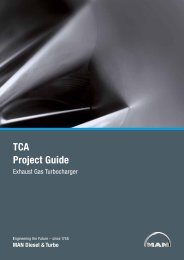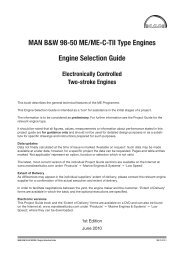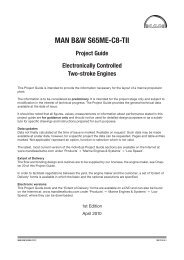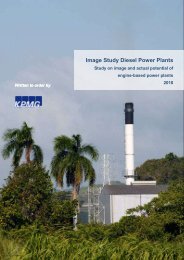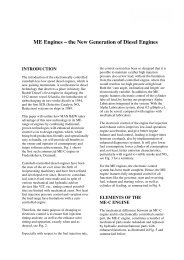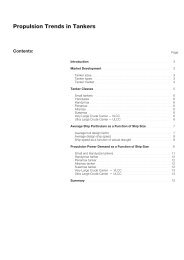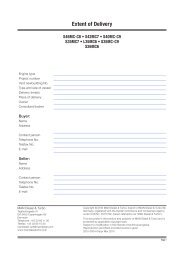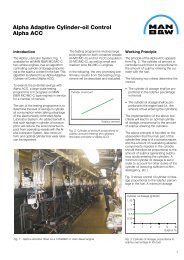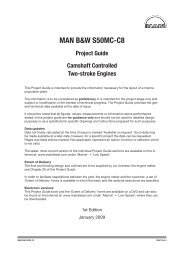This section is available on request - MAN Diesel & Turbo
This section is available on request - MAN Diesel & Turbo
This section is available on request - MAN Diesel & Turbo
Create successful ePaper yourself
Turn your PDF publications into a flip-book with our unique Google optimized e-Paper software.
<strong>MAN</strong> B&W 18.06<br />
Water In Oil M<strong>on</strong>itoring System<br />
In case the lubricating oil becomes c<strong>on</strong>taminated<br />
with an amount of water exceeding our limit of<br />
0.2%, acute corrosive wear of the crosshead bearing<br />
overlayer may occur. The higher the water c<strong>on</strong>tent,<br />
the faster the wear rate.<br />
To prevent water from accumulating in the lube<br />
oil and, thereby, causing damage to the bearings,<br />
the oil should be m<strong>on</strong>itored manually or automatically<br />
by means of a Water In Oil (WIO) m<strong>on</strong>itoring<br />
system c<strong>on</strong>nected to the engine alarm and m<strong>on</strong>itoring<br />
system. In case of water c<strong>on</strong>taminati<strong>on</strong><br />
the source should be found and the equipment<br />
inspected and repaired accordingly.<br />
The WIO system should trigger an alarm when<br />
the water c<strong>on</strong>tent exceeds 0.2%, and preferably<br />
again when exceeding 0.35% measured as absolute<br />
water c<strong>on</strong>tent.<br />
Some WIO systems measure water activity, ie<br />
the relative availability of water in a substance<br />
expressed in ‘aw’ <strong>on</strong> a scale from 0 to 1. Here, ‘0’<br />
indicates oil totally free of water and ‘1’ oil fully<br />
saturated by water. The correlati<strong>on</strong> to absolute<br />
water c<strong>on</strong>tent in normal running as well as alarm<br />
c<strong>on</strong>diti<strong>on</strong> <str<strong>on</strong>g>is</str<strong>on</strong>g> as follows:<br />
Engine c<strong>on</strong>diti<strong>on</strong> Abs. water Water<br />
c<strong>on</strong>tent, % activity, aw<br />
High alarm level 0.2 0.5<br />
High High alarm level 0.35 0.9<br />
ME, ME-C and ME-GI engines are as standard<br />
specified with Water In Oil m<strong>on</strong>itoring system.<br />
Please note: Corrosi<strong>on</strong> of the overlayer <str<strong>on</strong>g>is</str<strong>on</strong>g> a potential<br />
problem <strong>on</strong>ly for crosshead bearings, because<br />
<strong>on</strong>ly crosshead bearings are designed with an<br />
overlayer. Main and crankpin bearings may also<br />
suffer irreparable damage from water c<strong>on</strong>taminati<strong>on</strong>,<br />
but the damage mechan<str<strong>on</strong>g>is</str<strong>on</strong>g>m would be different<br />
and not as acute.<br />
Liner Wall M<strong>on</strong>itoring System<br />
Page 4 of 5<br />
The Liner Wall M<strong>on</strong>itoring (LWM) system m<strong>on</strong>itors<br />
the temperature of each cylinder liner. It <str<strong>on</strong>g>is</str<strong>on</strong>g> to<br />
be regarded as a tool providing the engine room<br />
crew the possibility to react with appropriate<br />
countermeasures in case the cylinder oil film <str<strong>on</strong>g>is</str<strong>on</strong>g><br />
indicating early signs of breakdown.<br />
In doing so, the LWM system can ass<str<strong>on</strong>g>is</str<strong>on</strong>g>t the crew<br />
in the recogniti<strong>on</strong> phase and help avoid c<strong>on</strong>sequential<br />
scuffing of the cylinder liner and p<str<strong>on</strong>g>is</str<strong>on</strong>g>t<strong>on</strong><br />
rings.<br />
Signs of oil film breakdown in a cylinder liner<br />
will appear by way of increased and fluctuating<br />
temperatures. Therefore, recording a preset max<br />
allowable absolute temperature for the individual<br />
cylinder or a max allowed deviati<strong>on</strong> from a calculated<br />
average of all sensors will trigger a cylinder<br />
liner temperature alarm.<br />
The LWM system includes two sensors placed in<br />
the manoeuvring and exhaust side of the liners,<br />
near the p<str<strong>on</strong>g>is</str<strong>on</strong>g>t<strong>on</strong> skirt TDC positi<strong>on</strong>. The sensors<br />
are interfaced to the ship alarm system which<br />
m<strong>on</strong>itors the liner temperatures.<br />
For each individual engine, the max and deviati<strong>on</strong><br />
alarm levels are optim<str<strong>on</strong>g>is</str<strong>on</strong>g>ed by m<strong>on</strong>itoring the temperature<br />
level of each sensor during normal service<br />
operati<strong>on</strong> and setting the levels accordingly.<br />
The temperature data <str<strong>on</strong>g>is</str<strong>on</strong>g> logged <strong>on</strong> a PC for <strong>on</strong>e<br />
week at least and preferably for the durati<strong>on</strong> of a<br />
round trip for reference of temperature development.<br />
All types 98 and 90 ME and ME-C engines as well<br />
as K80ME-C9 are as standard specified with Liner<br />
Wall M<strong>on</strong>itoring system. For all other engines, the<br />
LWM system <str<strong>on</strong>g>is</str<strong>on</strong>g> <str<strong>on</strong>g>available</str<strong>on</strong>g> as an opti<strong>on</strong>: 4 75 136.<br />
<strong>MAN</strong> B&W ME/ME�C/ME�GI engines 198 67 26�5.3<br />
<strong>MAN</strong> <strong>Diesel</strong>



